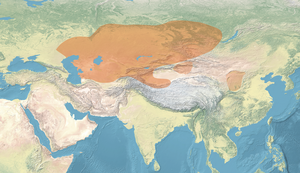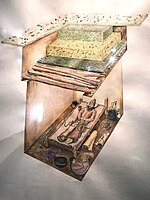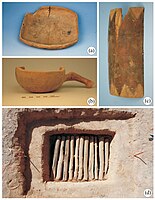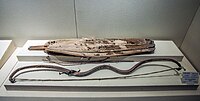Subeshi culture
General location of the Subeshi culture, next to the Saka realm ( ), and contemporary Asian polities c. 325 BCE | |
| Geographical range | Turpan, Xinjiang, China |
|---|---|
| Dates | 1100–100 BCE |
| Preceded by | Chemurchek culture |
| Followed by | Jushi Kingdom, Xiongnu |
The Subeshi culture (simplified Chinese: 苏贝希文化; traditional Chinese: 蘇貝希文化; 1100–100 BCE), also rendered as Subeishi culture or Subeixi culture, is an Iron Age culture from the area of Shanshan County, Turfan, Xinjiang, at the eastern edge of the Tarim Basin.[1] The Subeshi culture contributes some of the later period Tarim Mummies. It might be associated with the Jushi Kingdom known from Chinese historical sources.[2][1] The culture includes three closely related cemeteries:
- the Subeshi cemetery
- the Shengjindian cemetery,[1]
- the Yanghai cemetery.[3]
After 200 BCE, the Subeshi culture may have evolved into the later walled city-state culture of the Jushi Kingdom.[4]
Characteristics
The origins of the Subeshi culture were influenced by the cultures of West Asia and Central Asia as far back as the late Neolithic period and the early Bronze Age, when bronze technology, pottery and ornamation styles were introduced from the west, before spreading further east to the early cultures of China, such as the Siba culture (about 2000–1600 BCE), Qijia culture (2500–1500 BCE) or Chawuhugoukou culture (around 800–100 BCE).[1]
The Subeshi culture is known for its Iron Age graveyards of the 1st millennium BCE, which resemble those of the Saka (Scythian) Pazyryk culture of the Altai Mountains. In particular, weaponry, horse gear and garments are similar to those of the Pazyryk culture.[5]

The "Witches of Subeshi" (4th or 3rd century BCE) wore 2-foot-long (0.61 m) black felt conical hats with a flat brim.[7] Though modern Westerners tend to identify this type of hat as the headgear of a witch, there is evidence that these pointed hats were widely worn by both women and men in some Central Asian tribes. For instance, the Persian king Darius recorded a victory over the "Sakas of the pointed hats".[8] The Subeshi headgear is likely an ethnic badge or a symbol of position in the society. Also found at Subeshi was a man with traces of a surgical operation on his abdomen; the incision is sewn up with sutures made of horsehair.[9]
The Subeshi culture is a candidate for the Iron Age predecessors of the Tocharians.[10] The material culture of the Subeshi culture is very similar to that of Saka sites such as Arzhan or Tasmola, but is also known to have spread across the northern Chinese steppes from Xinjiang to the Korean Peninsula, particularly through bronze weapons, horse harnesses, and ornaments.[11] The Subeshi site of Yanghai yielded what maybe the world's oldest known horse saddle, already displaying many characteristics of today's modern saddles, for which a radiocarbon date of 727–396 BCE (95.4% probability range) has been obtained: this is contemporaneous of possibly older than the previous "oldest saddle" from the Scythian Pazyryk culture site of Tuekta barrow no. 1 (430–420 BCE).[12] Knotted carpet with colorful wave-like motifs were dated to 700 BCE, and are now the oldest known knotted carpet in the world, before the 4th century BCE Pazyryk carpets.[13]
Scythian-style bows were also discovered in Subeshi.[14] The technical sophistication of these bows suggests intense technological transfer between the Saka areas and the Subeishi culture areas. No other Tarim Basin area benefited from this technological transfer, which was supplemented by some adaptation by the Subeishi people: the bows were slightly bigger, and used lacquer as an original compounds, suggesting technological contact with China as well.[15]
In terms of genetics, Afanasievo ancestry has been identified among Iron Age Dzungarian populations.[16]
Origin and language
The language of the Subeshi mummies is unknown at this point. Looking at the linguistic history of the region, the Subeshi mummies may have spoken the Saka language (Khotanese Saka) or the Tocharian language, or an unknown language if they were derived from a local Neolithic group.[17] Many of the cultural traits of the Subeshi people, such as the tall pointed hats, may seriously suggest a Saka origin, but they could also be derived from the earlier Afanasievo culture.[18]
Artifacts
- Tomb at Yanghai cemetery
- Subeixi horse saddle.[21]
- Subeixi or Saka armour, 8th–3rd century BCE.[22]
- Wooden objects, Yanghai cemetery, Subeshi culture
- Subeshi culture earthenware. Turpan Museum.[23]
- Helmet-shaped earflap hat, Subeshi cemetery.[24]
- A Subeshi culture bow, c. 800 BCE, Xinjiang Museum
- Grapevine from Yanghai, said to be the ancestor of Chinese wine.[25]
- A wooden prosthetic leg from Shengjindian cemetery, c. 300 BCE, Turpan Museum. This is "the oldest functional leg prosthesis known to date".[26]
- Carpet from Yanghai-1, 7th century BCE.[13]
- Carpet from Yanghai-1, 7th century BCE.[13]
See also

 ) in the context of Iron Age continental Asia, with main sites of Subeixi, Shengjindian and Yanghai
) in the context of Iron Age continental Asia, with main sites of Subeixi, Shengjindian and Yanghai
- Astana Cemetery
- Xiaohe Cemetery
- Cherchen Man, an early contemporary from the southern area of the Tarim Basin
References
- ^ a b c d Zhang, Kai (4 February 2021). "The Spread and Integration of Painted pottery Art along the Silk Road". Region – Educational Research and Reviews. 3 (1): 18. doi:10.32629/RERR.V3I1.242. S2CID 234007445.
In the late Neolithic period and the early Bronze age, pottery, ornamentation and bronze culture with the characteristics of West Asia and Central Asia were introduced into Xinjiang, including Qijia culture (2500–1500 BC), Siba culture (about 2000–1600 BC), Chawuhugoukou culture (around 800–100 BC), Turpan Subeixi culture (1100 BC–100 BC) and other cultures.
- ^ Beck, Ulrike; Wagner, Mayke; Li, Xiao; Durkin-Meisterernst, Desmond; Tarasov, Pavel E. (20 October 2014). "The invention of trousers and its likely affiliation with horseback riding and mobility: A case study of late 2nd millennium BC finds from Turfan in eastern Central Asia". Quaternary International. 348: 225–226. Bibcode:2014QuInt.348..224B. doi:10.1016/j.quaint.2014.04.056. ISSN 1040-6182.
The Yanghai graveyard is assigned to the Subeixi (Subeshi) culture (e.g. Jiang et al., 2006, 2009), conventionally dated to the first millennium BC (Chen, 2002; Han, 2007; Xinjiang, 2011). The culture is associated with the Cheshi (Chü-shih) state known from Chinese historical sources (Sinor, 1990).
- ^ Jiang, Hongen; Li, Cheng-Sen; Cao, Hongyong; Shading, Palidanmu; Cheng, Ye-Ming (July 2021). "Wood Utilization During the Late Bronze to Early Iron Age in the Turpan Basin of Xinjiang, China, With Special Emphasis on Betula (Betulaceae)". SAGE Open. 11 (3): 215824402110469. doi:10.1177/21582440211046950. ISSN 2158-2440.
- ^ Lan-Hai Wei, Ryan; Li, Hui; Xu, Wenkan (26–28 June 2013). "The separate origins of the Tocharians and the Yuezhi: Results from recent advances in archaeology and genetics". Conference: International Conference on Tocharian Manuscripts and Silk Road Culture At: University of Vienna, Vienna: 285.
In the Turpan Basin area after 200 B.C., the Subeishi culture developed into the local walled nation-state called the Gushi Kingdom.
- ^ Li, Xiao; Wagner, Mayke; Wu, Xiaohong; Tarasov, Pavel; Zhang, Yongbin; Schmidt, Arno; Goslar, Tomasz; Gresky, Julia (21 March 2013). "Archaeological and palaeopathological study on the third/second century BC grave from Turfan, China: Individual health history and regional implications". Quaternary International. 290–291: 335–343. Bibcode:2013QuInt.290..335L. doi:10.1016/j.quaint.2012.05.010. ISSN 1040-6182. Archived from the original on 2 March 2024. Retrieved 21 October 2023.
The whole graveyard including tomb M2 belongs to the Subeixi culture, associated with the Cheshi (Chü-shih) state known from Chinese historical sources (Sinor, 1990). Archaeological and historical data attest it as society with a developed agro-pastoral economy, that existed in and north of the Turfan Basin (Fig. 1) during the first millennium BC. The Subeixi weaponry, horse gear and garments (Mallory and Mair, 2000; Lü, 2001) resemble those of the Pazyryk culture (Molodin and Polos'mak, 2007), suggesting contacts between Subeixi and the Scythians living in the Altai Mountains.
- ^ Wu, Guo (23 November 2022). Archaeological Research on the Societies of Late Prehistoric Xinjiang, Vol 2. Springer Nature. p. 183. ISBN 978-981-19-6889-1. Archived from the original on 14 November 2023. Retrieved 2 March 2024.
The animal style decorations of the Subeixi culture-Yanghai type barrel have direct or indirect relations with the Lu-shi – tall vertical slab (鹿石) from Tuva Arzan No.1
- ^ "Expedition Magazine Ancient Mummies of the Tarim Basin". Expedition Magazine. Archived from the original on 28 September 2023. Retrieved 21 October 2023.
- ^ Beaujard, Philippe (2019). "China: From Kingdoms to Unification". The Worlds of the Indian Ocean: A Global History: Volume 1: From the Fourth Millennium BCE to the Sixth Century CE. Cambridge University Press. p. 522. doi:10.1017/9781108341004.017. ISBN 978-1-108-42456-1. S2CID 241614518. Archived from the original on 2 March 2024. Retrieved 21 October 2023.
Hats either of the "Phrygian" type (Cherchen) or high and pointed (Subeshi, east of Turfan, c. Fifth Century BCE) have been discovered in the tombs; both are reminiscent of Iranian culture (Mallory and Mair Reference Mallory and Mair2000: figs. 111 and 125; Barber Reference Barber and Ten Grotenhuis2002: 64).
- ^ "The Mummies of Xinjiang". Discover. 1 April 1994. Archived from the original on 20 August 2019. Retrieved 21 October 2023.
- ^ Mallory, J. P. (2015). "The Problem of Tocharian Origins: An Archaeological Perspective" (PDF). Sino-Platonic Papers: 24. Archived (PDF) from the original on 20 October 2023. Retrieved 21 October 2023.
- ^ Wagner, Mayke; Wu, Xinhua; Tarasov, Pavel; Aisha, Ailijiang; Ramsey, Christopher Bronk; Schultz, Michael; Schmidt-Schultz, Tyede; Gresky, Julia (20 September 2011). "Radiocarbon-dated archaeological record of early first millennium B.C. mounted pastoralists in the Kunlun Mountains, China". Proceedings of the National Academy of Sciences of the United States of America. 108 (38): 15733–15738. Bibcode:2011PNAS..10815733W. doi:10.1073/pnas.1105273108. ISSN 0027-8424. PMC 3179056. PMID 21911387.
The Liushui bronze weaponry, particularly the very distinctive rhombic arrowheads with one side spur, and horse harnesses (Fig. 2) show great similarity to finds from kurgans (e.g., Arzhan 1 and Berlik in Fig. 1), with the inventories representing different steppe and forest-steppe cultures, such as Bol'shaya Rechka, Krasnoozero, and late Irmen' in Siberia (4); Tasmola and Zebakino-Dongal in Kazakhstan (4); and Subeshi in Xinjiang (31). Except for the rhombic socketed arrowheads, all other bronze weapons, horse harnesses, and ornaments have been found across the northern Chinese steppes from Xinjiang to the Korean Peninsula (32, 33).
- ^ Wertmann, Patrick; Yibulayinmu, Maria; Wagner, Mayke (1 September 2023). "The earliest directly dated saddle for horse-riding from a mid-1st millennium BCE female burial in Northwest China". Archaeological Research in Asia. 35: 100451. doi:10.1016/j.ara.2023.100451. ISSN 2352-2267.
Compared with the oldest known saddle from the Scythian Pazyryk culture site Tuekta barrow no. 1 (430–420 BCE) in north-western Altai, the Yanghai specimen radiocarbon dated to 727–396 BCE (95.4% probability range) is contemporaneous or possibly older.
- ^ a b c He, Zhang (2019). "Knotted Carpets from the Taklamakan: A Medium of Ideological and Aesthetic Exchange on the Silk Road, 700 BCE–700 CE" (PDF). The Silk Road. 17. Archived (PDF) from the original on 13 November 2023. Retrieved 2 March 2024.
Dated to as early as 700 BCE (Jia et al. 2009), the Yanghai carpet pieces are approximately three centuries older than the Pazyryk carpets (Rudenko 1970), making them the earliest knotted carpets found anywhere in the world.
- ^ Dwyer, Bede (1 January 2003). "Scythian-Style Bows Discovered in Xinjiang". Journal of the Society of Archer-Antiquaries. Archived from the original on 2 March 2024. Retrieved 21 October 2023.
- ^ Festa, Marcella. "Bronze Age communities and bronze metallurgy in Xinjiang" (PDF). Corso di Dottorato di ricerca in Studi sull'Africa e sull'Asia. Archived (PDF) from the original on 25 July 2022. Retrieved 2 March 2024.
Other than in the Scythian regions in the north and west, similar bows were discovered in the Turfan Basin, at the sites of Subeixi, Yanghai and Shengjindian (all dating to the first millennium BC by carbon dating and typological analysis), while there is little evidence in other areas of Xinjiang1199. Given that the complex shape of these bows was unlikely to have been accidental, it can be suggested that the knowhow for producing these objects came from the northern Scythian region, in South-western Siberia, and reached Southern Xinjiang across the Turfan Basin....
- ^ Zhang, Fan; Ning, Chao; Scott, Ashley (2021). "The genomic origins of the Bronze Age Tarim Basin mummies". Nature. 599 (7884): 256–261. Bibcode:2021Natur.599..256Z. doi:10.1038/s41586-021-04052-7. ISSN 0028-0836. PMC 8580821. PMID 34707286.
However, although Afanasievo-related ancestry has been confirmed among Iron Age Dzungarian populations (around 200–400 BC)7, and Tocharian is recorded in Buddhist texts from the Tarim Basin dating to ad 500–1000 (ref. 13), little is known about earlier Xinjiang populations and their possible genetic relationships with the Afanasievo or other groups.
- ^ Mallory, J. P. "Bronze Age Languages of the Tarim Basin" (PDF). Expedition. 52 (3): 46. Archived (PDF) from the original on 2 March 2024. Retrieved 2 March 2024.
Once one excludes all the languages imported by foreign missionaries, outside merchants, Chinese administrators, and later Turkic invaders, we are effectively left with two main language groups in the Tarim Basin that might be associated with at least some of the Tarim mummies of the Bronze Age and Iron Age: Khotanese Saka (or any other remnant of the Scythians of the Eurasian steppe) and Tocharian. Of course, totally different languages may have been spoken by these populations, especially if they were derived from native Neolithic groups, whose languages did not survive into the historical record.
- ^ Mallory, J. P. "Bronze Age Languages of the Tarim Basin" (PDF). Expedition. 52 (3): 50. Archived (PDF) from the original on 2 March 2024. Retrieved 2 March 2024.
The tall hats of the female mummies from Subeshi might also pass for a Saka trait, and so identification of some of the mummies with the Saka or Iranian speakers in the northeast Tarim is a serious possibility (...)
- ^ Xin, Xiaoyu (2015). "Research on Prehistoric Hats in Xinjiang (2000 BC–200 BC)". Asian Social Science. 11 (7). doi:10.5539/ASS.V11N7P333. S2CID 56018775.
- ^ Beaujard, Philippe (2010). "From Three Possible Iron-Age World-Systems to a Single Afro-Eurasian World-System". Journal of World History. 21 (1): 9, note 20. ISSN 1045-6007. JSTOR 20752924. Archived from the original on 1 November 2023. Retrieved 21 October 2023.
- ^ Wertmann, Patrick; Yibulayinmu, Maria; Wagner, Mayke; Taylor, Chris; Müller, Samira; Xu, Dongliang; Elkina, Irina; Leipe, Christian; Deng, Yonghong; Tarasov, Pavel E. (1 September 2023). "The earliest directly dated saddle for horse-riding from a mid-1st millennium BCE female burial in Northwest China". Archaeological Research in Asia. 35: 100451. doi:10.1016/j.ara.2023.100451. ISSN 2352-2267. Archived from the original on 26 May 2023. Retrieved 21 October 2023.
- ^ "Scale Armor Subeixi or Scythian". The Metropolitan Museum of Art. Archived from the original on 6 June 2016. Retrieved 21 October 2023.
- ^ Shao, Hui-qiu. "Research on the Subeixi Culture in Xinjiang" (PDF). 边疆考古研究. Archived (PDF) from the original on 1 November 2023. Retrieved 2 March 2024.
- ^ Xin, Xiaoyu (2015). "Research on Prehistoric Hats in Xinjiang (2000 BC–200 BC)". Asian Social Science. 11 (7). doi:10.5539/ASS.V11N7P333. S2CID 56018775.
- ^ Jiang, H. (2009). "Evidence for early viticulture in China: Proof of a grapevine (Vitis vinifera L., Vitaceae) in the Yanghai tombs, Xinjiang". Journal of Archaeological Science. 36 (7): 1458–1465. Bibcode:2009JArSc..36.1458J. doi:10.1016/j.jas.2009.02.010. Archived from the original on 1 November 2023. Retrieved 2 March 2024.
A stem was discovered in the Yanghai Tombs, Turpan District in Xinjiang, China. Anatomical features showed it to be of grape (Vitis vinifera L.). Radiocarbon dating indicates it to be nearly 2300 years old, which would suggest that there was grape cultivation at least from that time. To date, this is the earliest physical evidence of V. vinifera cultivation in China.(...) By the studying of the ancient grapevine, we have gained new insight into the viticulture in China. Based on the physical evidence, we have been able to confirm one of the conclusions drawn by Yang (2003), namely that the cultivated grape (V. vinifera) was introduced into Xinjiang around 300 BCE. On the other hand, we would also argue that the earliest grape cultivation in China was not in the western and southern part of the Tarim Basin, but in the Turpan Basin, based on the evidence to date.
- ^ Li, Xiao; Wagner, Mayke; Wu, Xiaohong; Tarasov, Pavel; Zhang, Yongbin; Schmidt, Arno; Goslar, Tomasz; Gresky, Julia (21 March 2013). "Archaeological and palaeopathological study on the third/second century BC grave from Turfan, China: Individual health history and regional implications". Quaternary International. 290–291: 335–343. Bibcode:2013QuInt.290..335L. doi:10.1016/j.quaint.2012.05.010. ISSN 1040-6182. Archived from the original on 2 March 2024. Retrieved 21 October 2023.
Ten radiocarbon dates on the prosthesis, human bones and wood pieces from the same grave suggest the most probable age of the burial is about 300–200 BC (68% confidence interval), thus introducing the oldest functional leg prosthesis known to date.




![Cone-shaped high-peaked hat, Subeshi cemetery.[19][20]](https://upload.wikimedia.org/wikipedia/commons/thumb/c/cd/Cone-shaped_high-peaked_hat%2C_Subeshi_cemetery.jpg/108px-Cone-shaped_high-peaked_hat%2C_Subeshi_cemetery.jpg)
![Subeixi horse saddle.[21]](https://upload.wikimedia.org/wikipedia/commons/thumb/5/59/Subeixi_saddle_-_Wertmann_et_al_2023.jpeg/176px-Subeixi_saddle_-_Wertmann_et_al_2023.jpeg)
![Subeixi or Saka armour, 8th–3rd century BCE.[22]](https://upload.wikimedia.org/wikipedia/commons/thumb/9/98/Subeixi_or_Saka_armour%2C_8th-3rd_century_BCE.jpg/106px-Subeixi_or_Saka_armour%2C_8th-3rd_century_BCE.jpg)

![Subeshi culture earthenware. Turpan Museum.[23]](https://upload.wikimedia.org/wikipedia/commons/thumb/c/cb/Subeshi_culture_earthenware.jpg/166px-Subeshi_culture_earthenware.jpg)
![Helmet-shaped earflap hat, Subeshi cemetery.[24]](https://upload.wikimedia.org/wikipedia/commons/thumb/e/e4/Helmet-shaped_earflap_hat%2C_Subeshi_cemetery.jpg/200px-Helmet-shaped_earflap_hat%2C_Subeshi_cemetery.jpg)

![Grapevine from Yanghai, said to be the ancestor of Chinese wine.[25]](https://upload.wikimedia.org/wikipedia/commons/thumb/e/eb/%E4%B8%AD%E5%9B%BD%E6%9C%80%E6%97%A9%E7%9A%84%E8%91%A1%E8%90%84%E8%97%A4.jpg/200px-%E4%B8%AD%E5%9B%BD%E6%9C%80%E6%97%A9%E7%9A%84%E8%91%A1%E8%90%84%E8%97%A4.jpg)
![A wooden prosthetic leg from Shengjindian cemetery, c. 300 BCE, Turpan Museum. This is "the oldest functional leg prosthesis known to date".[26]](https://upload.wikimedia.org/wikipedia/commons/thumb/5/5f/Shengjindian_prosthetic_leg%2C_300-200_BCE.jpg/200px-Shengjindian_prosthetic_leg%2C_300-200_BCE.jpg)
![Carpet from Yanghai-1, 7th century BCE.[13]](https://upload.wikimedia.org/wikipedia/commons/thumb/8/83/Yanghai_carpet%2C_7th_century_BCE.jpg/200px-Yanghai_carpet%2C_7th_century_BCE.jpg)
![Carpet from Yanghai-1, 7th century BCE.[13]](https://upload.wikimedia.org/wikipedia/commons/thumb/2/2d/Yanghai_carpet%2C_7th_century_BCE_%282%29.jpg/200px-Yanghai_carpet%2C_7th_century_BCE_%282%29.jpg)